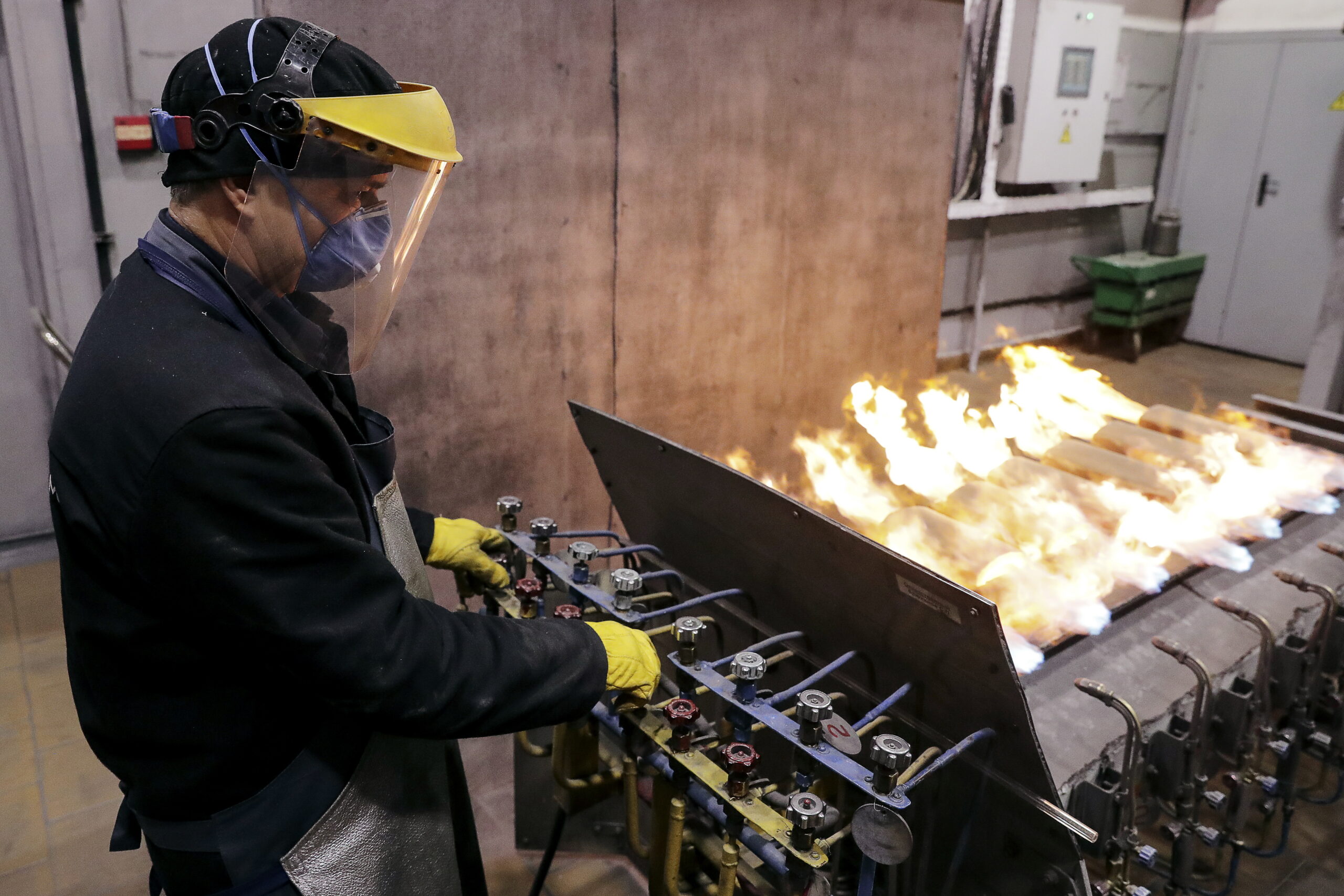As the invasion of Ukraine grinds past the half-year mark, Russian policymakers have finally begun to reckon with the scale of the economic crisis on their hands. A combination of falling oil prices, a stronger ruble, and falling tax revenues from consumption led to a 900 billion ruble budget deficit for the month of July alone.
In response, Denis Manturov has been given a role on Prime Minister Mishustin’s team, elevating industrial policy’s importance as new debates are taking shape about how to re-engineer economic policy. More liberal voices represented by Eduard Rossel’ from the Federation Council’s committee on the budget and financial markets have begun calling for expansive deficit spending at rates up to 5 trillion rubles annually over the next 3-year budget window. That said, the Ministry of Finance under Anton Siluanov remain opposed. For the foreseeable future, the Ministry will instead draw down money from the National Welfare Fund and issue a limited amount of debt to domestic investors.
The crux is that any significant increase in spending risks unleashing inflation from a variety of shortfalls like limited access to parallel imports hit by controls and self-sanctioning and the loss of migrant labor from Central Asia. The economy is, therefore, in the early stages of a negative feedback loop. Falling revenues lead to falling federal spending, which then crimps investment, jobs, and incomes. In this light, Russia’s buckling metallurgical sector offers a useful lens to think through what may happen next across the economy.
Peddling Metal
MinPromTorg’s strategy document for the metallurgical sector lays out a grim scenario. It will take an estimated 8 years for exports and domestic demand to fully recover to pre-invasion levels. Ongoing adaptations to sanctions, particularly the loss of higher-end technological imports from Europe, will continue until around 2025 and the next 5 years will be spent clawing back market share. Asian markets are poorly situated to make up lost sales in Europe or across the broader ‘West’ because China’s massive overcapacity across most forms of metals production forces Russian firms to sell at discounts (now often 10−20% because of political risks). Russian companies also have to spend more on transportation to Asia, and now lose out from an artificially strong ruble propped up through capital controls in the face of a stark loss of imports.
The Ministry is now forecasting demand for iron and aluminum to halve in 2022, falling to 220−250,000 and 720−760,000 tons respectively. Roughly 97% of iron production is used in steel, so by implication the Ministry expects a collapse in construction and industrial steel consumption. Aluminum is similarly used for construction purposes, but is also affected by the collapse in automotive production — light automobile manufacture was down 61% year-on-year for H1 and has fallen so far that Uzbekistan leads the CIS in light automotive production for the year.
Falling iron ore demand implies a significant fall in domestic nickel demand. Heading into 2022, roughly 70% of nickel is consumed in the production of stainless steel. Nornickel depends on exports for its earnings, and saw its EBITDA decline 16.1% year-on-year for H1 along with its profit margins because of sanctions-related increases in logistical costs despite sky-high nickel prices. The company lacks any significant new projects in the pipeline too. That means more output which has to find a foreign consumer must be sold at a relative discount, and potentially cost more to transport.
What’s Mined Is Yours
Metallurgy sits downstream from mining, which means that declining domestic metallurgical demand and rising production costs — Rusal recorded a 33% year-on-year increase for H1, for instance — affect miners on top of the fallout from sanctions. Coal producers sell coking coal (and some thermal coal) to metallurgical firms and coal power plants in exchange for rubles while exporting coal to foreign markets for foreign currency. Russian coal production is now undergoing a significant contraction because an EU import ban has finally taken effect. Kemerovo oblast, where 80% of Russia’s coking coal is mined, now faces a situation where mines are closing or throttling down millions of tons of production.
By no means can the Russian economy absorb all domestic production for domestic consumption in normal circumstances, but the loss of export markets for miners and falling output leads to lower demand for rolling stock and freight infrastructure broadly conceived. There is currently an estimated surplus of approximately 81,500 gondola cars, open-topped cars used to haul loose bulk materials such as coal and ores, on the national rail network. Similar imbalances exist for other categories of railwagon. These wagons require significant volumes of steel and aluminium to be built. The surplus drives down freight rates and the profitability of continuing production at the same time factories have struggled to produce more on time or even repair existing ones because of shortages of bearings. Declines in coal exports feed through to declines in domestic demand for metals, and by extension other domestically mined minerals like iron ore or bauxite.
Construction creates the same dynamics. A paltry 200 billion rubles is being spent on subsidies for construction firms to combat what is currently estimated to be a 10−20% decline in net construction demand. That translates into falling demand for steel and aluminium as well as falling domestic demand for nickel, most of which is used as an input for stainless steel used to build things. Losses of domestic demand then necessitate finding external buyers to maintain current output levels, let alone expand them.
Finding Disequilibrium
The Bank of Russia provides the underlying rationale for the metallurgical sector’s stabilization by 2025. It’s expected that the broader economy will «bottom out» in 2024 and return to growth, though with a likely over-optimistic 1.5−2.5% annualized growth rate. The Bank’s forecast doesn’t quite add up. The Ministry of Finance is hard-pressed to keep the budget deficit from ballooning. Attempts to use fiscal stimulus to generate growth will produce significant inflation from the combination of export controls, self-sanctioning, financial sanctions affecting the use of US dollars and Euros for imports, and the slower-burning effect of a declining labor force and weaker incentives for migrant laborers to move to Russia.
By early July, MinFin was already looking to shave 1.6 trillion rubles from the next three-year budget plan. The Ministry has also pushed to delay the implementation of new calculations for pension payments till 2025 to reduce budget expenditures and, per former Gorbachev advisor Abel Agenbegyan, roughly 18% of the population is already living in poverty and that figure may rise to 25−30% as the current crisis peaks. The exact figures are debatable, but that’s a nightmare for budget policy given efforts to reduce the federal budget’s dependence on oil & gas revenues since 2014 were driven in large part by increasing the tax burden and efficacy of taxation on consumption as well as personal incomes and small business profits.
As demand falls, so do revenues. As revenues fall, the pressure to cut spending increases. It’s a cycle that creates a long-term disequilibrium whereby the economy must continually keep finding its ‘floor.’ Finding it by 2024 seems exceedingly optimistic and reflective of the increasing pressure from the Kremlin on technocrats to deliver economic stability within 3 years. Disequilibrium then feeds through to metals demand and the supply of relevant inputs as each sector adjusts. And note that most of Russia’s mineral and metals exports are selling at discounts, as high as 50% against other major international benchmarks in the case of coal.
Things Can Always Be Worse
The EU has already banned the import of steel and aluminium from Russia, disrupting prior investment plans from major Russian metallurgical firms seeking to reduce their emissions intensity in advance of the EU’s forthcoming carbon border adjustment mechanism (CBAM). Even if they aren’t selling to European markets, decarbonization is set to become a problem for their competitiveness in the coming years. Whatever one’s scenario for the Russian economy through 2025, it’s exceedingly difficult to imagine metallurgical firms have much incentive to sink lots of capital into such efforts when costs are so much higher and parallel imports are unlikely to prove adequate to meet the economy’s needs.
Present forecasts are likely underpricing the coming economic losses from these various disequilibriums, whether they be budgetary, based on inventories of goods like railwagons, or affected by slowing global growth. The worst is yet to come.










